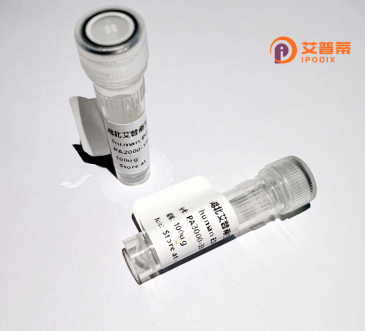
| 纯度 | >90%SDS-PAGE. |
| 种属 | Human |
| 靶点 | ANKH |
| Uniprot No | Q9HCJ1 |
| 内毒素 | < 0.01EU/μg |
| 表达宿主 | E.coli |
| 表达区间 | 1-492aa |
| 氨基酸序列 | MVKFPALTHYWPLIRFLVPLGITNIAIDFGEQALNRGIAAVKEDAVEMLASYGLAYSLMKFFTGPMSDFKNVGLVFVNSKRDRTKAVLCMVVAGAIAAVFHTLIAYSDLGYYIINKLHHVDESVGSKTRRAFLYLAAFPFMDAMAWTHAGILLKHKYSFLVGCASISDVIAQVVFVAILLHSHLECREPLLIPILSLYMGALVRCTTLCLGYYKNIHDIIPDRSGPELGGDATIRKMLSFWWPLALILATQRISRPIVNLFVSRDLGGSSAATEAVAILTATYPVGHMPYGWLTEIRAVYPAFDKNNPSNKLVSTSNTVTAAHIKKFTFVCMALSLTLCFVMFWTPNVSEKILIDIIGVDFAFAELCVVPLRIFSFFPVPVTVRAHLTGWLMTLKKTFVLAPSSVLRIIVLIASLVVLPYLGVHGATLGVGSLLAGFVGESTMVAIAACYVYRKQKKKMENESATEGEDSAMTDMPPTEEVTDIVEMREENE |
| 分子量 | 54 kDa |
| 蛋白标签 | His tag N-Terminus |
| 缓冲液 | 冻干粉 |
| 稳定性 & 储存条件 | Lyophilized protein should be stored at ≤ -20°C, stable for one year after receipt. Reconstituted protein solution can be stored at 2-8°C for 2-7 days. Aliquots of reconstituted samples are stable at ≤ -20°C for 3 months. |
| 复溶 | Always centrifuge tubes before opening.Do not mix by vortex or pipetting. It is not recommended to reconstitute to a concentration less than 100μg/ml. Dissolve the lyophilized protein in distilled water. Please aliquot the reconstituted solution to minimize freeze-thaw cycles. |
以下是关于ANKH基因相关研究的参考文献示例(注:具体文献信息需进一步验证):
1. **"Mutations in ANKH cause chondrocalcinosis"**
- **作者**: Pendleton A, Johnson KR, Ayers KM, et al.
- **摘要**: 研究发现ANKH基因突变与家族性焦磷酸钙晶体沉积病(CPPD)相关,探讨其通过调节细胞外焦磷酸盐水平影响关节矿化过程。
2. **"The ANKH gene and its role in phosphate homeostasis"**
- **作者**: Zaka R, Williams CJ.
- **摘要**: 综述ANKH基因编码蛋白在维持细胞内外磷酸盐平衡中的作用,强调其与骨矿化和关节炎疾病(如软骨钙化症)的关联。
3. **"Functional characterization of ANKH in osteoblast differentiation"**
- **作者**: Chen Y, Hashimoto K, Srinivas S.
- **摘要**: 通过体外实验验证ANKH在成骨细胞分化中的功能,发现其通过调控焦磷酸盐抑制异位骨化,可能与骨代谢疾病相关。
4. **"Regulation of extracellular pyrophosphate by ANKH in articular chondrocytes"**
- **作者**: Wang W, Xu J, Kirsch T.
- **摘要**: 研究报道ANKH蛋白在关节软骨细胞中通过转运焦磷酸盐调控细胞外环境,并探讨其在退行性关节病变中的作用机制。
**备注**:上述文献主要围绕ANKH的基因功能及疾病关联性展开,直接针对“重组人ANKH蛋白”的研究较少。建议结合关键词“ANKH gene”“bone mineralization”“pyrophosphate”进一步检索,或关注焦磷酸盐代谢相关通路研究。
Ankyrin Homolog (ANKH), also known as progressive ankylosis protein homolog, is a transmembrane protein encoded by the ANKH gene in humans. It plays a critical role in regulating extracellular inorganic pyrophosphate (PPi) and phosphate (Pi) levels, which are essential for maintaining normal bone mineralization and preventing pathological calcification. By facilitating PPi transport across cell membranes, ANKH inhibits ectopic ossification, a process where soft tissues abnormally calcify. Dysregulation of ANKH function is linked to genetic disorders such as craniometaphyseal dysplasia (CMD) and calcium pyrophosphate deposition disease (CPPD), highlighting its importance in skeletal homeostasis.
Research on recombinant human ANKH has focused on elucidating its molecular mechanisms and therapeutic potential. Recombinant ANKH proteins are produced using expression systems like mammalian cells to ensure proper post-translational modifications. These proteins enable studies on PPi metabolism, bone remodeling, and pathological calcification pathways. Additionally, ANKH is explored as a therapeutic target for diseases involving abnormal mineralization, with strategies aiming to modulate its activity or expression. While animal models, such as the *ank/ank* mouse, have provided insights into ANKH’s role in skeletal development, further research is needed to fully translate findings into clinical applications, including targeted therapies for mineralization disorders.
×